Human Resource Management Report: Training, Factors, & Acts
VerifiedAdded on 2022/08/12
|12
|2621
|10
Report
AI Summary
This report, prepared for a Human Resource Management course (BUS532), examines key aspects of HRM within the context of Spark New Zealand. The report begins with a detailed training schedule, outlining objectives, target audience, content delivery, and expected outcomes. It then delves into the internal and external factors influencing HR implementation, specifically focusing on financial and cultural factors internally, and political and technological factors externally. The report also identifies and explains the role of relevant New Zealand Acts regulating workplace practices, including the Employment Relations Act 2000, the Wages Protection Act 1983, and the Privacy Act 1993. Furthermore, it suggests strategies for human resources departments to enhance organizational performance, such as leveraging technology, promoting skills development, and communicating clear expectations. Finally, the report concludes with an analysis of different performance appraisal methods, providing reasons for selecting each method within an organizational context. The report provides valuable insights into the practical application of HRM principles and practices.
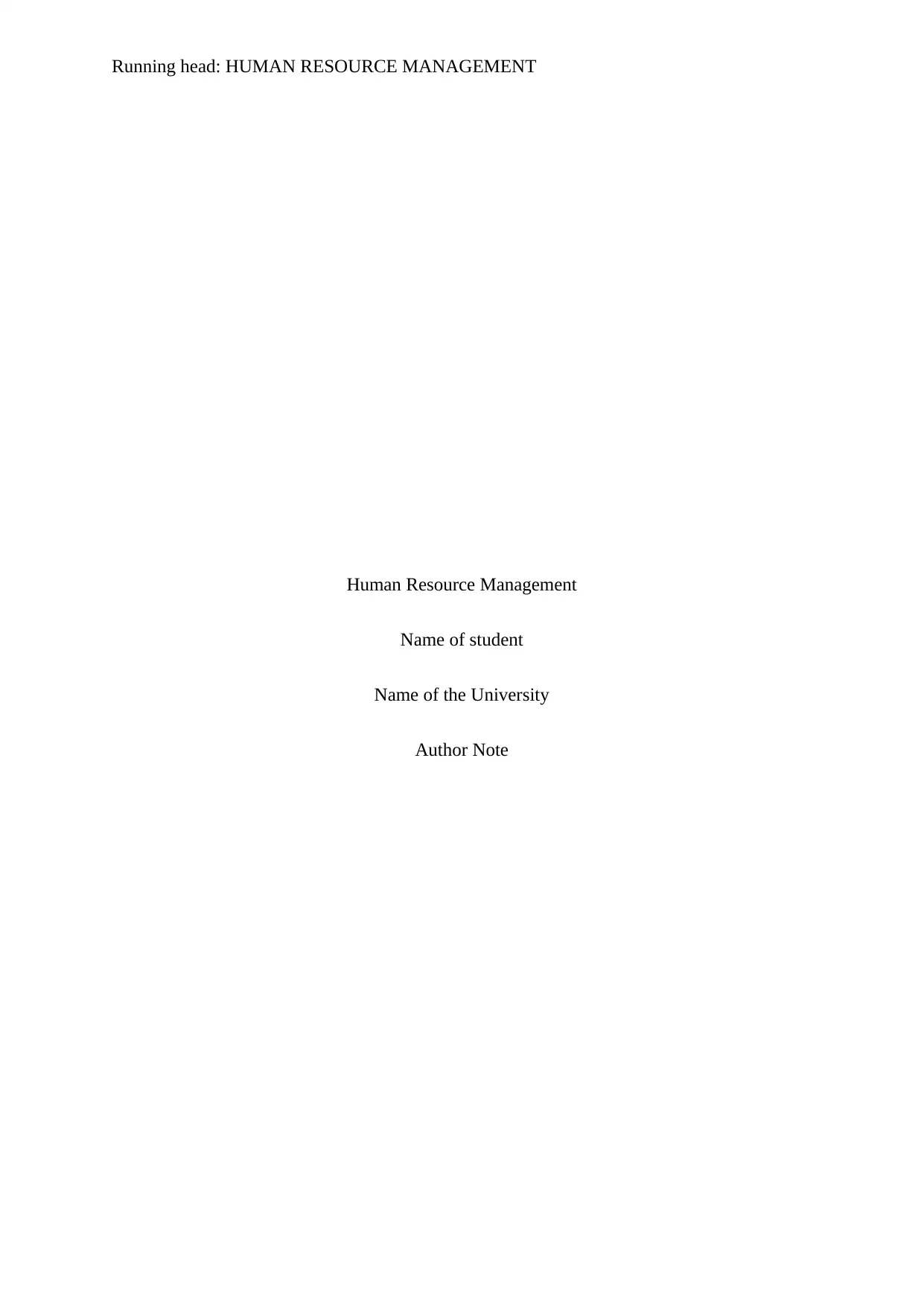
Running head: HUMAN RESOURCE MANAGEMENT
Human Resource Management
Name of student
Name of the University
Author Note
Human Resource Management
Name of student
Name of the University
Author Note
Paraphrase This Document
Need a fresh take? Get an instant paraphrase of this document with our AI Paraphraser
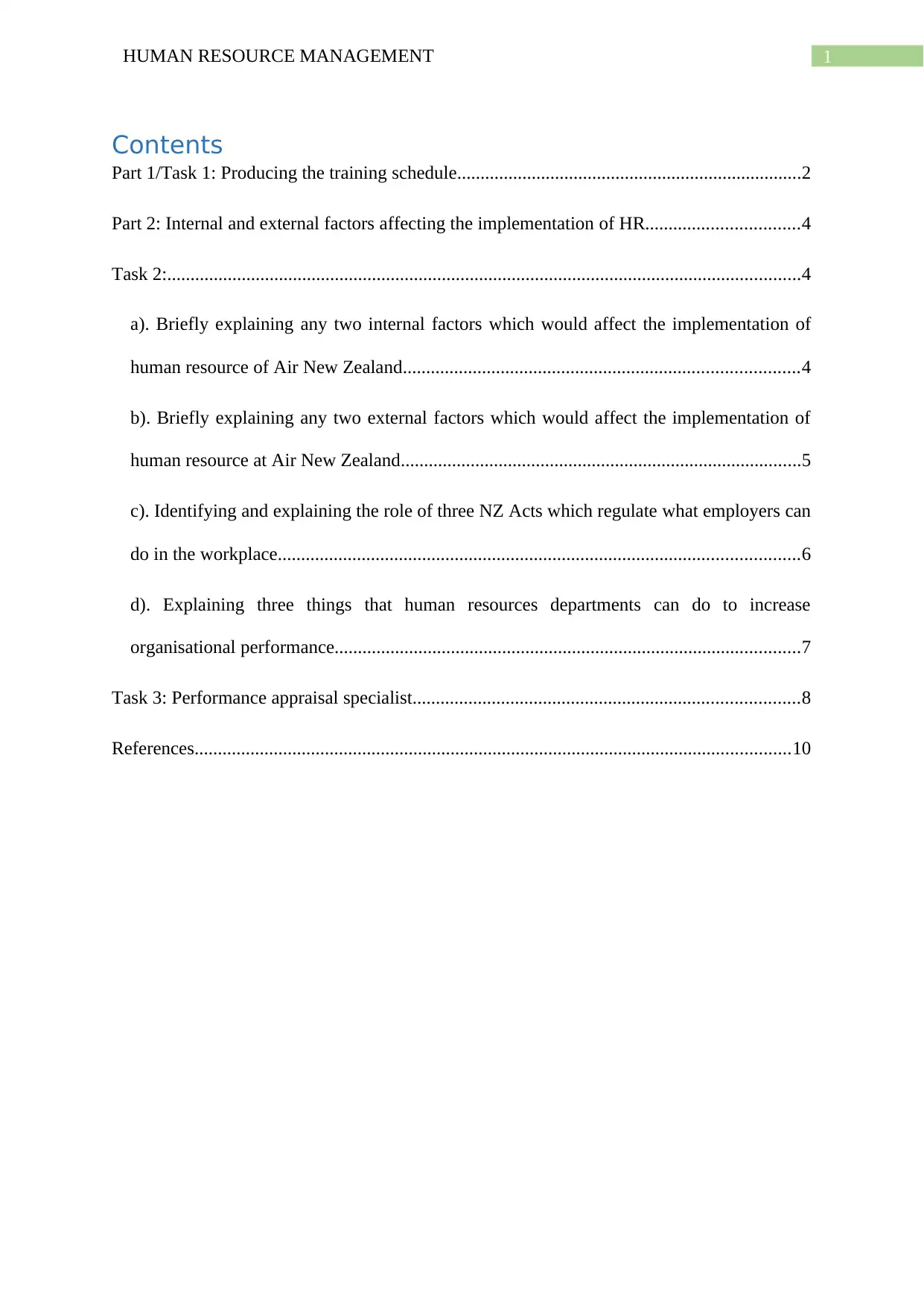
1HUMAN RESOURCE MANAGEMENT
Contents
Part 1/Task 1: Producing the training schedule..........................................................................2
Part 2: Internal and external factors affecting the implementation of HR.................................4
Task 2:........................................................................................................................................4
a). Briefly explaining any two internal factors which would affect the implementation of
human resource of Air New Zealand.....................................................................................4
b). Briefly explaining any two external factors which would affect the implementation of
human resource at Air New Zealand......................................................................................5
c). Identifying and explaining the role of three NZ Acts which regulate what employers can
do in the workplace................................................................................................................6
d). Explaining three things that human resources departments can do to increase
organisational performance....................................................................................................7
Task 3: Performance appraisal specialist...................................................................................8
References................................................................................................................................10
Contents
Part 1/Task 1: Producing the training schedule..........................................................................2
Part 2: Internal and external factors affecting the implementation of HR.................................4
Task 2:........................................................................................................................................4
a). Briefly explaining any two internal factors which would affect the implementation of
human resource of Air New Zealand.....................................................................................4
b). Briefly explaining any two external factors which would affect the implementation of
human resource at Air New Zealand......................................................................................5
c). Identifying and explaining the role of three NZ Acts which regulate what employers can
do in the workplace................................................................................................................6
d). Explaining three things that human resources departments can do to increase
organisational performance....................................................................................................7
Task 3: Performance appraisal specialist...................................................................................8
References................................................................................................................................10
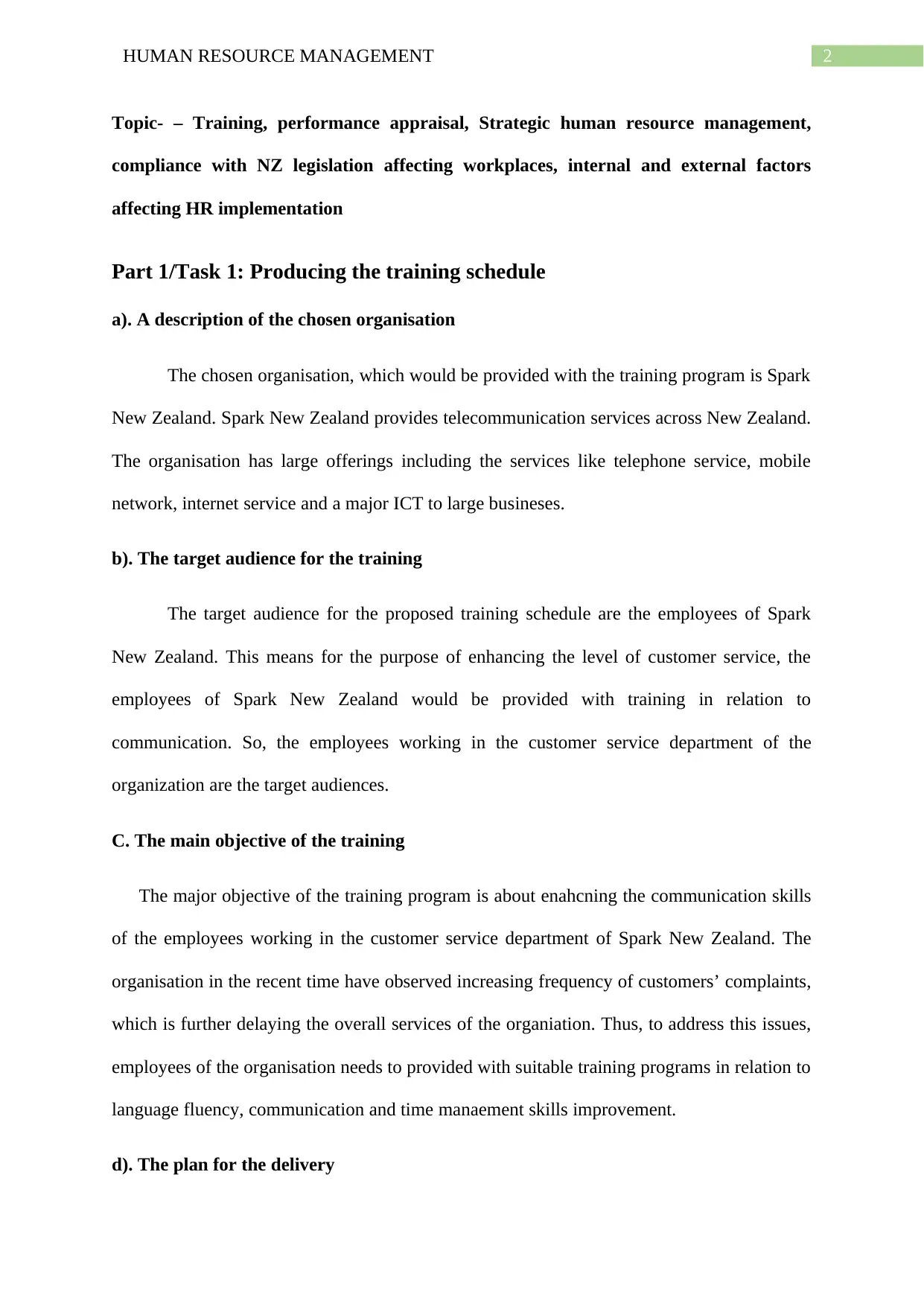
2HUMAN RESOURCE MANAGEMENT
Topic- – Training, performance appraisal, Strategic human resource management,
compliance with NZ legislation affecting workplaces, internal and external factors
affecting HR implementation
Part 1/Task 1: Producing the training schedule
a). A description of the chosen organisation
The chosen organisation, which would be provided with the training program is Spark
New Zealand. Spark New Zealand provides telecommunication services across New Zealand.
The organisation has large offerings including the services like telephone service, mobile
network, internet service and a major ICT to large busineses.
b). The target audience for the training
The target audience for the proposed training schedule are the employees of Spark
New Zealand. This means for the purpose of enhancing the level of customer service, the
employees of Spark New Zealand would be provided with training in relation to
communication. So, the employees working in the customer service department of the
organization are the target audiences.
C. The main objective of the training
The major objective of the training program is about enahcning the communication skills
of the employees working in the customer service department of Spark New Zealand. The
organisation in the recent time have observed increasing frequency of customers’ complaints,
which is further delaying the overall services of the organiation. Thus, to address this issues,
employees of the organisation needs to provided with suitable training programs in relation to
language fluency, communication and time manaement skills improvement.
d). The plan for the delivery
Topic- – Training, performance appraisal, Strategic human resource management,
compliance with NZ legislation affecting workplaces, internal and external factors
affecting HR implementation
Part 1/Task 1: Producing the training schedule
a). A description of the chosen organisation
The chosen organisation, which would be provided with the training program is Spark
New Zealand. Spark New Zealand provides telecommunication services across New Zealand.
The organisation has large offerings including the services like telephone service, mobile
network, internet service and a major ICT to large busineses.
b). The target audience for the training
The target audience for the proposed training schedule are the employees of Spark
New Zealand. This means for the purpose of enhancing the level of customer service, the
employees of Spark New Zealand would be provided with training in relation to
communication. So, the employees working in the customer service department of the
organization are the target audiences.
C. The main objective of the training
The major objective of the training program is about enahcning the communication skills
of the employees working in the customer service department of Spark New Zealand. The
organisation in the recent time have observed increasing frequency of customers’ complaints,
which is further delaying the overall services of the organiation. Thus, to address this issues,
employees of the organisation needs to provided with suitable training programs in relation to
language fluency, communication and time manaement skills improvement.
d). The plan for the delivery
⊘ This is a preview!⊘
Do you want full access?
Subscribe today to unlock all pages.

Trusted by 1+ million students worldwide
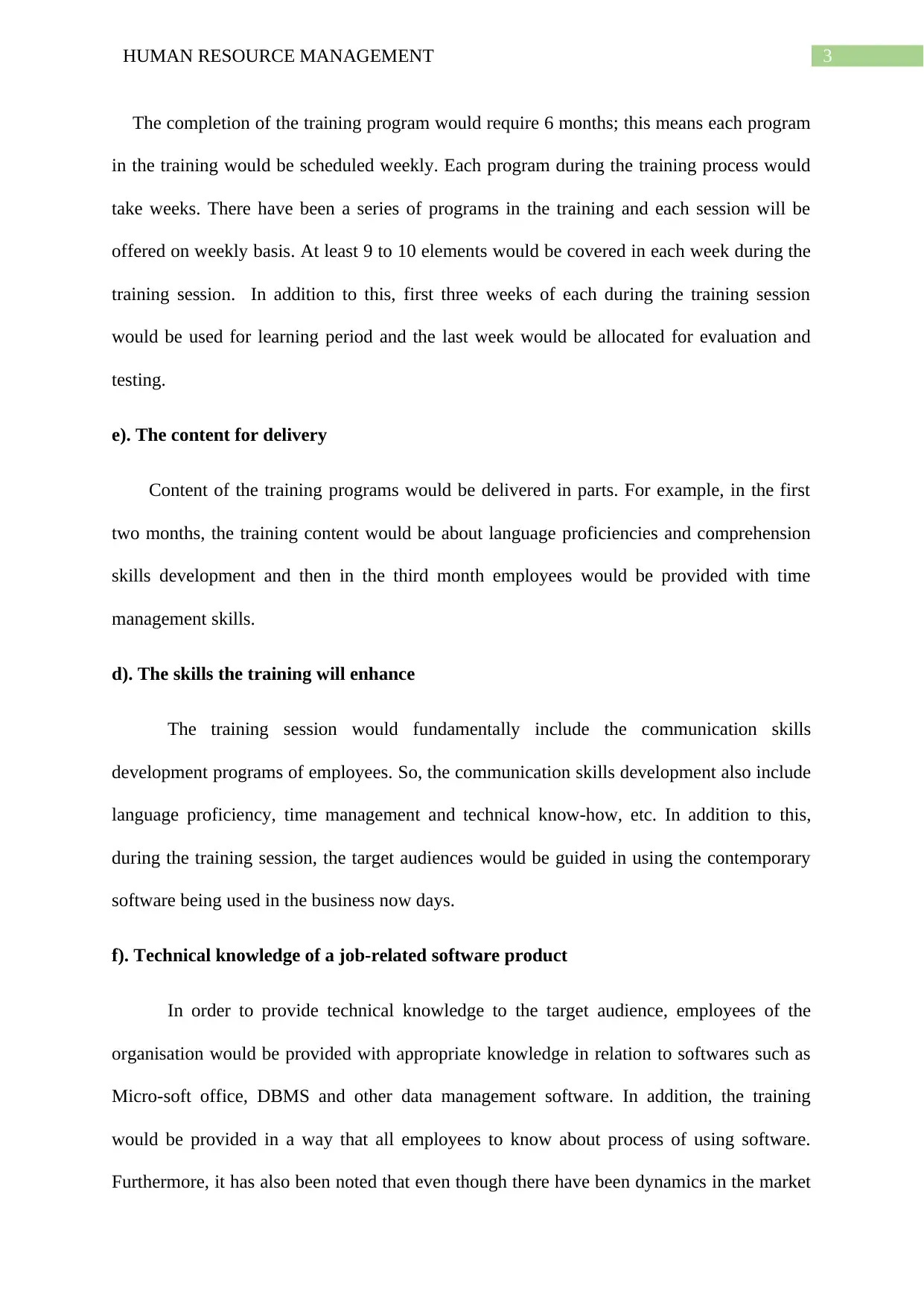
3HUMAN RESOURCE MANAGEMENT
The completion of the training program would require 6 months; this means each program
in the training would be scheduled weekly. Each program during the training process would
take weeks. There have been a series of programs in the training and each session will be
offered on weekly basis. At least 9 to 10 elements would be covered in each week during the
training session. In addition to this, first three weeks of each during the training session
would be used for learning period and the last week would be allocated for evaluation and
testing.
e). The content for delivery
Content of the training programs would be delivered in parts. For example, in the first
two months, the training content would be about language proficiencies and comprehension
skills development and then in the third month employees would be provided with time
management skills.
d). The skills the training will enhance
The training session would fundamentally include the communication skills
development programs of employees. So, the communication skills development also include
language proficiency, time management and technical know-how, etc. In addition to this,
during the training session, the target audiences would be guided in using the contemporary
software being used in the business now days.
f). Technical knowledge of a job-related software product
In order to provide technical knowledge to the target audience, employees of the
organisation would be provided with appropriate knowledge in relation to softwares such as
Micro-soft office, DBMS and other data management software. In addition, the training
would be provided in a way that all employees to know about process of using software.
Furthermore, it has also been noted that even though there have been dynamics in the market
The completion of the training program would require 6 months; this means each program
in the training would be scheduled weekly. Each program during the training process would
take weeks. There have been a series of programs in the training and each session will be
offered on weekly basis. At least 9 to 10 elements would be covered in each week during the
training session. In addition to this, first three weeks of each during the training session
would be used for learning period and the last week would be allocated for evaluation and
testing.
e). The content for delivery
Content of the training programs would be delivered in parts. For example, in the first
two months, the training content would be about language proficiencies and comprehension
skills development and then in the third month employees would be provided with time
management skills.
d). The skills the training will enhance
The training session would fundamentally include the communication skills
development programs of employees. So, the communication skills development also include
language proficiency, time management and technical know-how, etc. In addition to this,
during the training session, the target audiences would be guided in using the contemporary
software being used in the business now days.
f). Technical knowledge of a job-related software product
In order to provide technical knowledge to the target audience, employees of the
organisation would be provided with appropriate knowledge in relation to softwares such as
Micro-soft office, DBMS and other data management software. In addition, the training
would be provided in a way that all employees to know about process of using software.
Furthermore, it has also been noted that even though there have been dynamics in the market
Paraphrase This Document
Need a fresh take? Get an instant paraphrase of this document with our AI Paraphraser
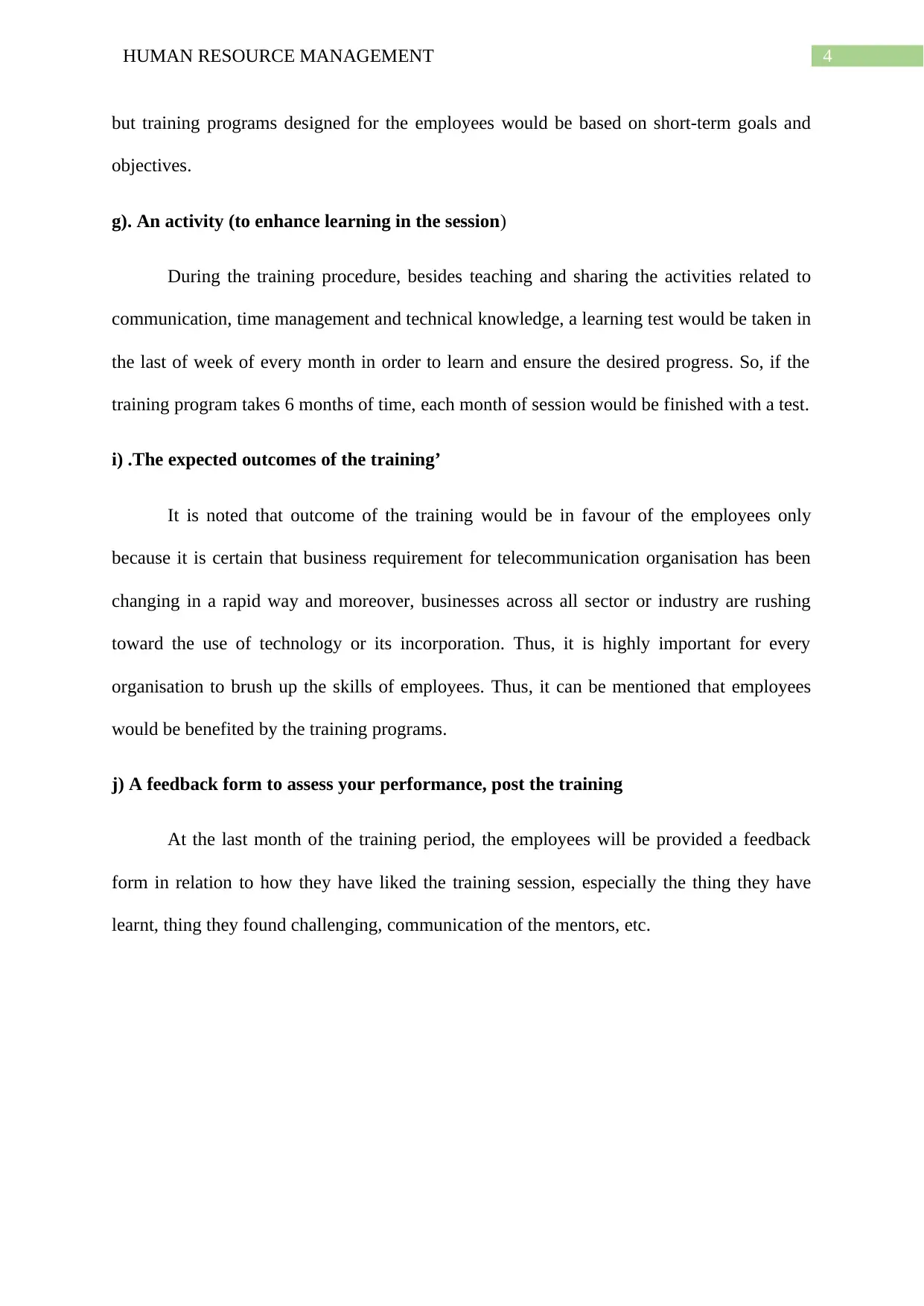
4HUMAN RESOURCE MANAGEMENT
but training programs designed for the employees would be based on short-term goals and
objectives.
g). An activity (to enhance learning in the session)
During the training procedure, besides teaching and sharing the activities related to
communication, time management and technical knowledge, a learning test would be taken in
the last of week of every month in order to learn and ensure the desired progress. So, if the
training program takes 6 months of time, each month of session would be finished with a test.
i) .The expected outcomes of the training’
It is noted that outcome of the training would be in favour of the employees only
because it is certain that business requirement for telecommunication organisation has been
changing in a rapid way and moreover, businesses across all sector or industry are rushing
toward the use of technology or its incorporation. Thus, it is highly important for every
organisation to brush up the skills of employees. Thus, it can be mentioned that employees
would be benefited by the training programs.
j) A feedback form to assess your performance, post the training
At the last month of the training period, the employees will be provided a feedback
form in relation to how they have liked the training session, especially the thing they have
learnt, thing they found challenging, communication of the mentors, etc.
but training programs designed for the employees would be based on short-term goals and
objectives.
g). An activity (to enhance learning in the session)
During the training procedure, besides teaching and sharing the activities related to
communication, time management and technical knowledge, a learning test would be taken in
the last of week of every month in order to learn and ensure the desired progress. So, if the
training program takes 6 months of time, each month of session would be finished with a test.
i) .The expected outcomes of the training’
It is noted that outcome of the training would be in favour of the employees only
because it is certain that business requirement for telecommunication organisation has been
changing in a rapid way and moreover, businesses across all sector or industry are rushing
toward the use of technology or its incorporation. Thus, it is highly important for every
organisation to brush up the skills of employees. Thus, it can be mentioned that employees
would be benefited by the training programs.
j) A feedback form to assess your performance, post the training
At the last month of the training period, the employees will be provided a feedback
form in relation to how they have liked the training session, especially the thing they have
learnt, thing they found challenging, communication of the mentors, etc.
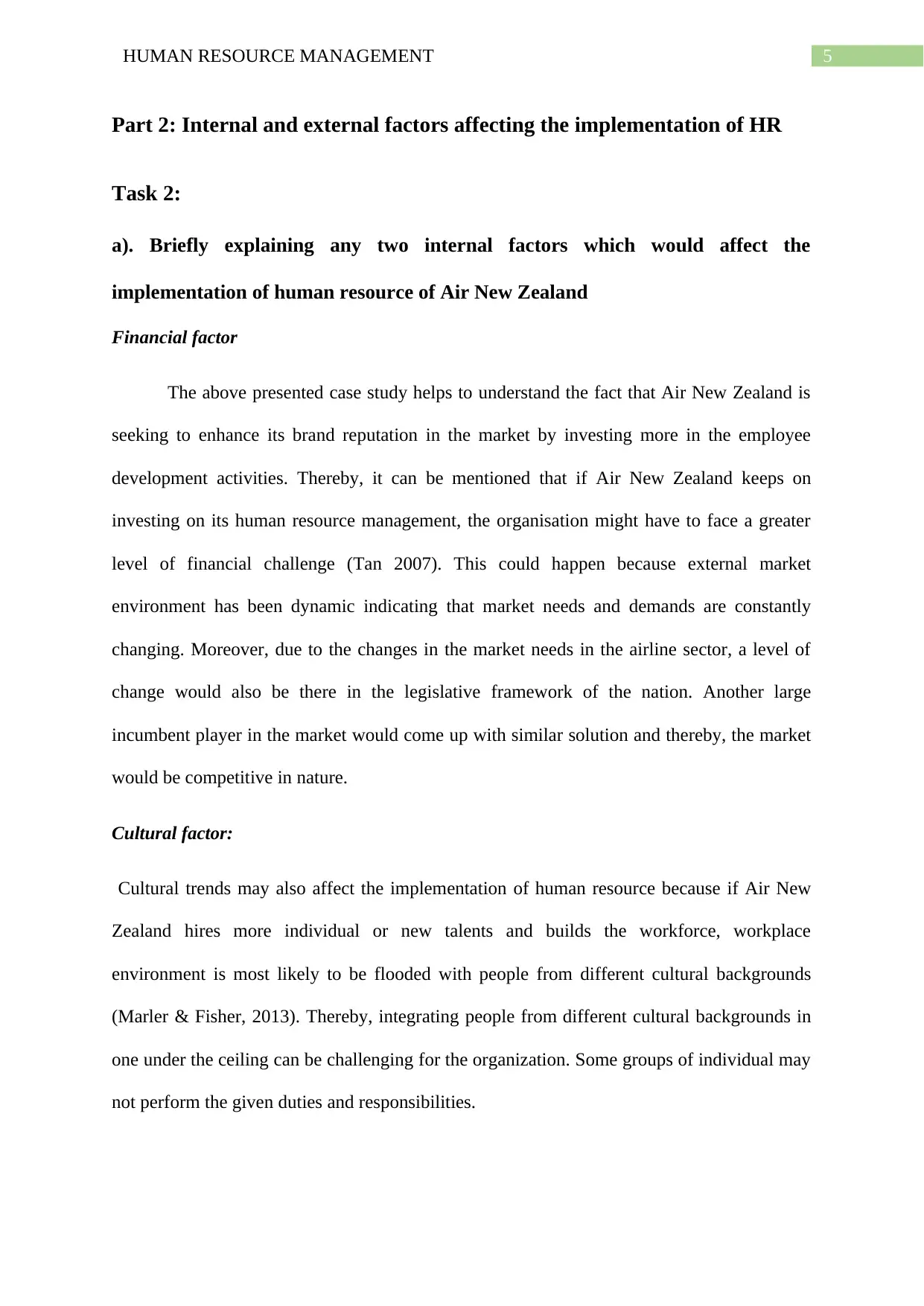
5HUMAN RESOURCE MANAGEMENT
Part 2: Internal and external factors affecting the implementation of HR
Task 2:
a). Briefly explaining any two internal factors which would affect the
implementation of human resource of Air New Zealand
Financial factor
The above presented case study helps to understand the fact that Air New Zealand is
seeking to enhance its brand reputation in the market by investing more in the employee
development activities. Thereby, it can be mentioned that if Air New Zealand keeps on
investing on its human resource management, the organisation might have to face a greater
level of financial challenge (Tan 2007). This could happen because external market
environment has been dynamic indicating that market needs and demands are constantly
changing. Moreover, due to the changes in the market needs in the airline sector, a level of
change would also be there in the legislative framework of the nation. Another large
incumbent player in the market would come up with similar solution and thereby, the market
would be competitive in nature.
Cultural factor:
Cultural trends may also affect the implementation of human resource because if Air New
Zealand hires more individual or new talents and builds the workforce, workplace
environment is most likely to be flooded with people from different cultural backgrounds
(Marler & Fisher, 2013). Thereby, integrating people from different cultural backgrounds in
one under the ceiling can be challenging for the organization. Some groups of individual may
not perform the given duties and responsibilities.
Part 2: Internal and external factors affecting the implementation of HR
Task 2:
a). Briefly explaining any two internal factors which would affect the
implementation of human resource of Air New Zealand
Financial factor
The above presented case study helps to understand the fact that Air New Zealand is
seeking to enhance its brand reputation in the market by investing more in the employee
development activities. Thereby, it can be mentioned that if Air New Zealand keeps on
investing on its human resource management, the organisation might have to face a greater
level of financial challenge (Tan 2007). This could happen because external market
environment has been dynamic indicating that market needs and demands are constantly
changing. Moreover, due to the changes in the market needs in the airline sector, a level of
change would also be there in the legislative framework of the nation. Another large
incumbent player in the market would come up with similar solution and thereby, the market
would be competitive in nature.
Cultural factor:
Cultural trends may also affect the implementation of human resource because if Air New
Zealand hires more individual or new talents and builds the workforce, workplace
environment is most likely to be flooded with people from different cultural backgrounds
(Marler & Fisher, 2013). Thereby, integrating people from different cultural backgrounds in
one under the ceiling can be challenging for the organization. Some groups of individual may
not perform the given duties and responsibilities.
⊘ This is a preview!⊘
Do you want full access?
Subscribe today to unlock all pages.

Trusted by 1+ million students worldwide
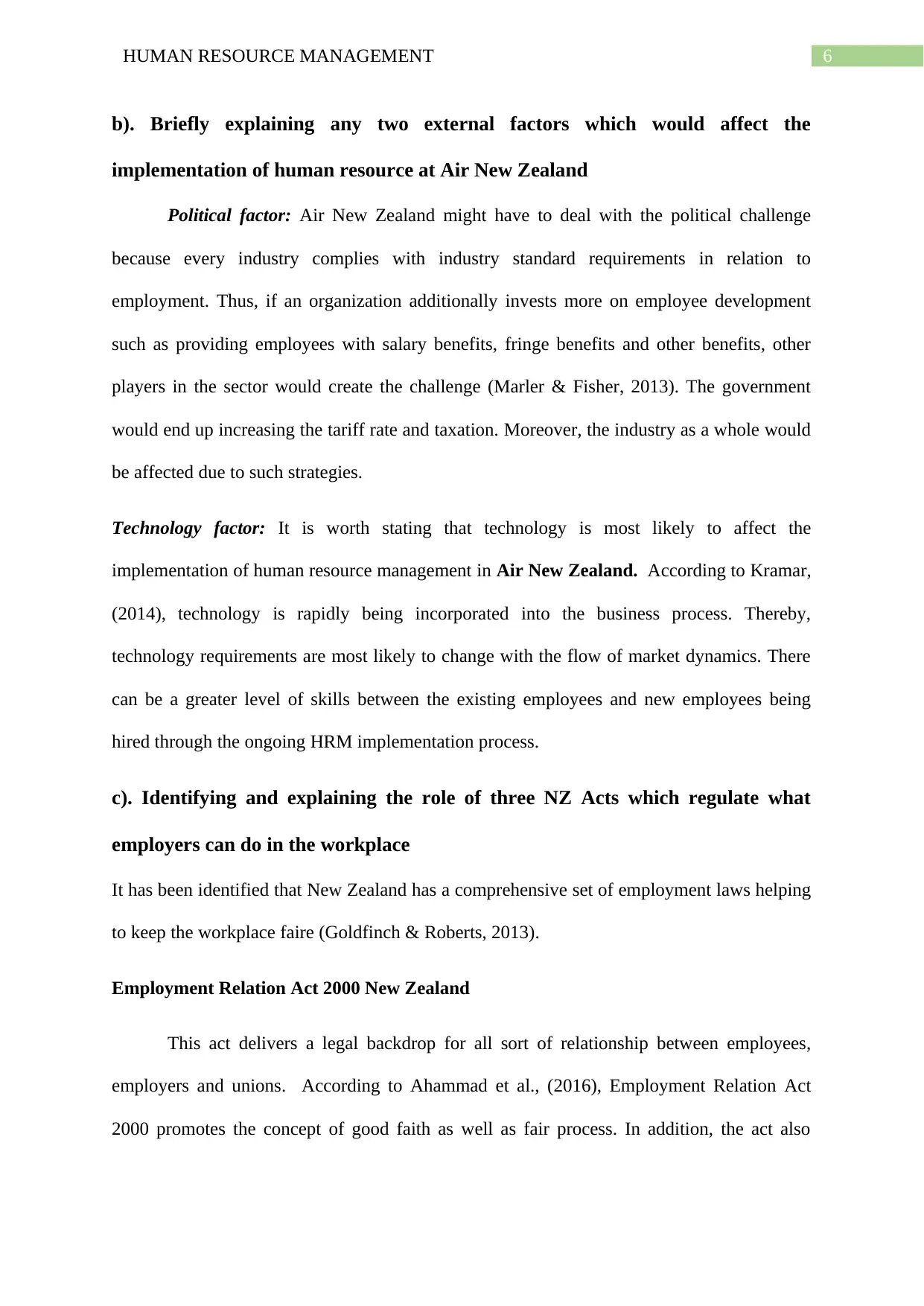
6HUMAN RESOURCE MANAGEMENT
b). Briefly explaining any two external factors which would affect the
implementation of human resource at Air New Zealand
Political factor: Air New Zealand might have to deal with the political challenge
because every industry complies with industry standard requirements in relation to
employment. Thus, if an organization additionally invests more on employee development
such as providing employees with salary benefits, fringe benefits and other benefits, other
players in the sector would create the challenge (Marler & Fisher, 2013). The government
would end up increasing the tariff rate and taxation. Moreover, the industry as a whole would
be affected due to such strategies.
Technology factor: It is worth stating that technology is most likely to affect the
implementation of human resource management in Air New Zealand. According to Kramar,
(2014), technology is rapidly being incorporated into the business process. Thereby,
technology requirements are most likely to change with the flow of market dynamics. There
can be a greater level of skills between the existing employees and new employees being
hired through the ongoing HRM implementation process.
c). Identifying and explaining the role of three NZ Acts which regulate what
employers can do in the workplace
It has been identified that New Zealand has a comprehensive set of employment laws helping
to keep the workplace faire (Goldfinch & Roberts, 2013).
Employment Relation Act 2000 New Zealand
This act delivers a legal backdrop for all sort of relationship between employees,
employers and unions. According to Ahammad et al., (2016), Employment Relation Act
2000 promotes the concept of good faith as well as fair process. In addition, the act also
b). Briefly explaining any two external factors which would affect the
implementation of human resource at Air New Zealand
Political factor: Air New Zealand might have to deal with the political challenge
because every industry complies with industry standard requirements in relation to
employment. Thus, if an organization additionally invests more on employee development
such as providing employees with salary benefits, fringe benefits and other benefits, other
players in the sector would create the challenge (Marler & Fisher, 2013). The government
would end up increasing the tariff rate and taxation. Moreover, the industry as a whole would
be affected due to such strategies.
Technology factor: It is worth stating that technology is most likely to affect the
implementation of human resource management in Air New Zealand. According to Kramar,
(2014), technology is rapidly being incorporated into the business process. Thereby,
technology requirements are most likely to change with the flow of market dynamics. There
can be a greater level of skills between the existing employees and new employees being
hired through the ongoing HRM implementation process.
c). Identifying and explaining the role of three NZ Acts which regulate what
employers can do in the workplace
It has been identified that New Zealand has a comprehensive set of employment laws helping
to keep the workplace faire (Goldfinch & Roberts, 2013).
Employment Relation Act 2000 New Zealand
This act delivers a legal backdrop for all sort of relationship between employees,
employers and unions. According to Ahammad et al., (2016), Employment Relation Act
2000 promotes the concept of good faith as well as fair process. In addition, the act also
Paraphrase This Document
Need a fresh take? Get an instant paraphrase of this document with our AI Paraphraser
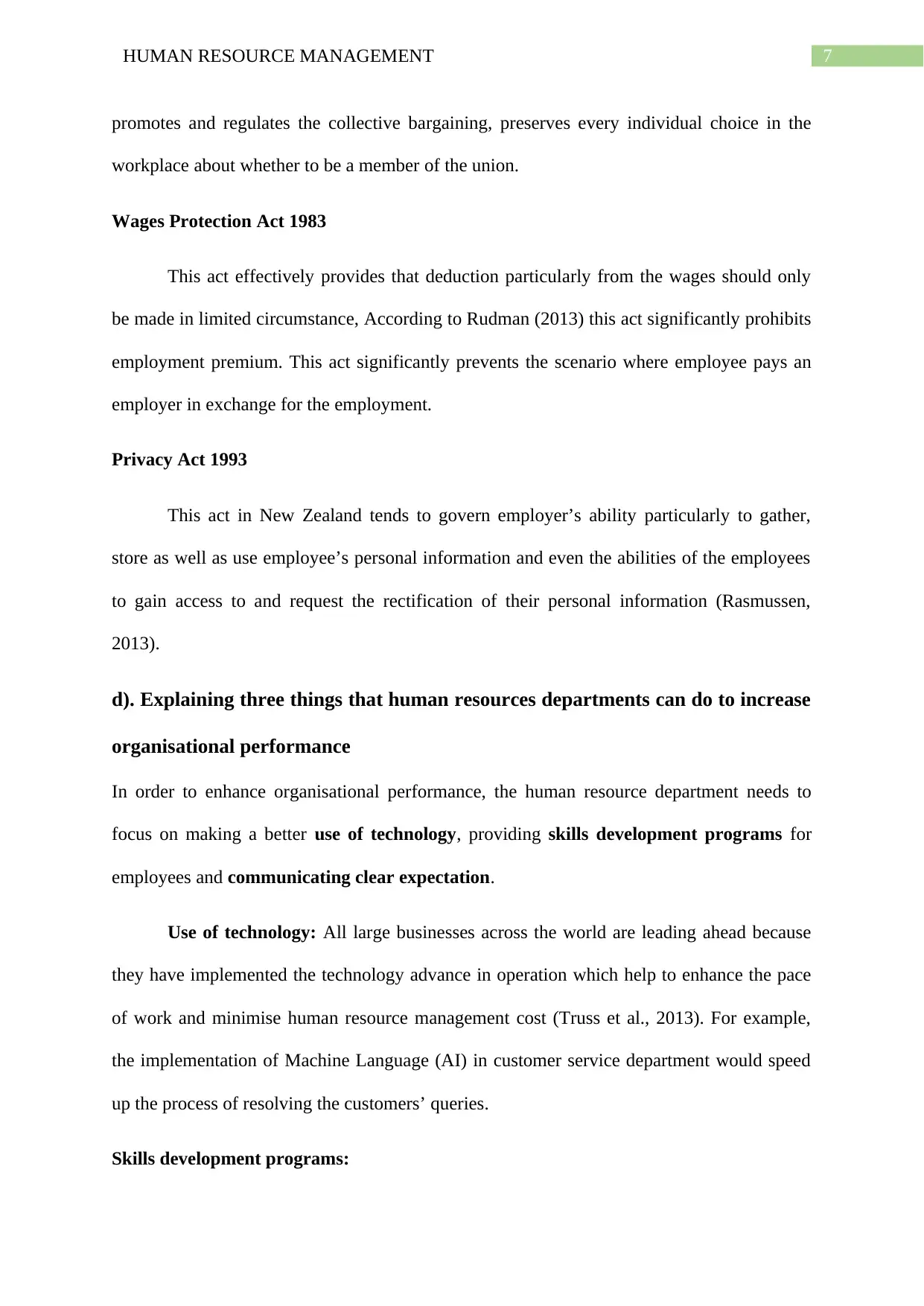
7HUMAN RESOURCE MANAGEMENT
promotes and regulates the collective bargaining, preserves every individual choice in the
workplace about whether to be a member of the union.
Wages Protection Act 1983
This act effectively provides that deduction particularly from the wages should only
be made in limited circumstance, According to Rudman (2013) this act significantly prohibits
employment premium. This act significantly prevents the scenario where employee pays an
employer in exchange for the employment.
Privacy Act 1993
This act in New Zealand tends to govern employer’s ability particularly to gather,
store as well as use employee’s personal information and even the abilities of the employees
to gain access to and request the rectification of their personal information (Rasmussen,
2013).
d). Explaining three things that human resources departments can do to increase
organisational performance
In order to enhance organisational performance, the human resource department needs to
focus on making a better use of technology, providing skills development programs for
employees and communicating clear expectation.
Use of technology: All large businesses across the world are leading ahead because
they have implemented the technology advance in operation which help to enhance the pace
of work and minimise human resource management cost (Truss et al., 2013). For example,
the implementation of Machine Language (AI) in customer service department would speed
up the process of resolving the customers’ queries.
Skills development programs:
promotes and regulates the collective bargaining, preserves every individual choice in the
workplace about whether to be a member of the union.
Wages Protection Act 1983
This act effectively provides that deduction particularly from the wages should only
be made in limited circumstance, According to Rudman (2013) this act significantly prohibits
employment premium. This act significantly prevents the scenario where employee pays an
employer in exchange for the employment.
Privacy Act 1993
This act in New Zealand tends to govern employer’s ability particularly to gather,
store as well as use employee’s personal information and even the abilities of the employees
to gain access to and request the rectification of their personal information (Rasmussen,
2013).
d). Explaining three things that human resources departments can do to increase
organisational performance
In order to enhance organisational performance, the human resource department needs to
focus on making a better use of technology, providing skills development programs for
employees and communicating clear expectation.
Use of technology: All large businesses across the world are leading ahead because
they have implemented the technology advance in operation which help to enhance the pace
of work and minimise human resource management cost (Truss et al., 2013). For example,
the implementation of Machine Language (AI) in customer service department would speed
up the process of resolving the customers’ queries.
Skills development programs:
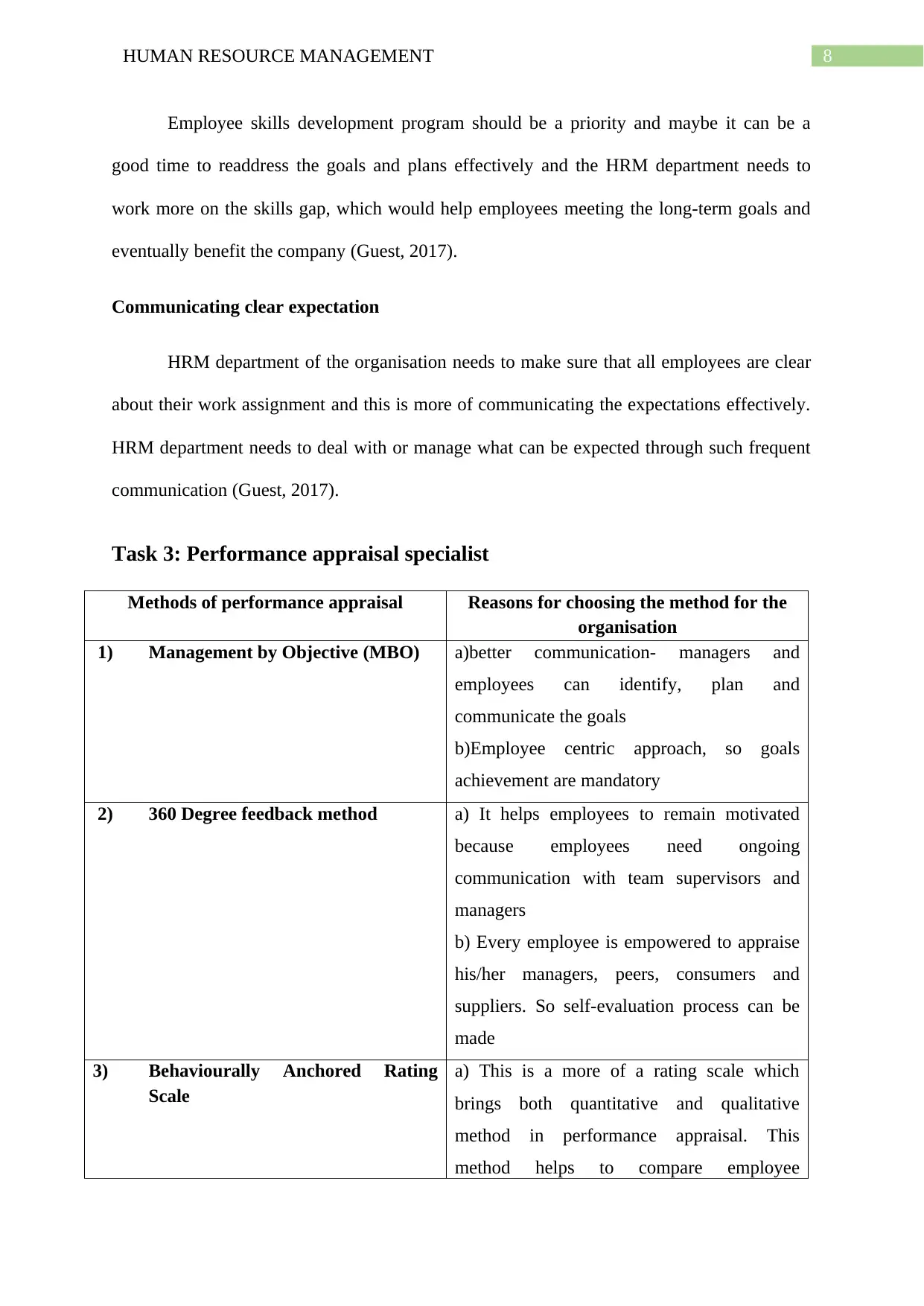
8HUMAN RESOURCE MANAGEMENT
Employee skills development program should be a priority and maybe it can be a
good time to readdress the goals and plans effectively and the HRM department needs to
work more on the skills gap, which would help employees meeting the long-term goals and
eventually benefit the company (Guest, 2017).
Communicating clear expectation
HRM department of the organisation needs to make sure that all employees are clear
about their work assignment and this is more of communicating the expectations effectively.
HRM department needs to deal with or manage what can be expected through such frequent
communication (Guest, 2017).
Task 3: Performance appraisal specialist
Methods of performance appraisal Reasons for choosing the method for the
organisation
1) Management by Objective (MBO) a)better communication- managers and
employees can identify, plan and
communicate the goals
b)Employee centric approach, so goals
achievement are mandatory
2) 360 Degree feedback method a) It helps employees to remain motivated
because employees need ongoing
communication with team supervisors and
managers
b) Every employee is empowered to appraise
his/her managers, peers, consumers and
suppliers. So self-evaluation process can be
made
3) Behaviourally Anchored Rating
Scale
a) This is a more of a rating scale which
brings both quantitative and qualitative
method in performance appraisal. This
method helps to compare employee
Employee skills development program should be a priority and maybe it can be a
good time to readdress the goals and plans effectively and the HRM department needs to
work more on the skills gap, which would help employees meeting the long-term goals and
eventually benefit the company (Guest, 2017).
Communicating clear expectation
HRM department of the organisation needs to make sure that all employees are clear
about their work assignment and this is more of communicating the expectations effectively.
HRM department needs to deal with or manage what can be expected through such frequent
communication (Guest, 2017).
Task 3: Performance appraisal specialist
Methods of performance appraisal Reasons for choosing the method for the
organisation
1) Management by Objective (MBO) a)better communication- managers and
employees can identify, plan and
communicate the goals
b)Employee centric approach, so goals
achievement are mandatory
2) 360 Degree feedback method a) It helps employees to remain motivated
because employees need ongoing
communication with team supervisors and
managers
b) Every employee is empowered to appraise
his/her managers, peers, consumers and
suppliers. So self-evaluation process can be
made
3) Behaviourally Anchored Rating
Scale
a) This is a more of a rating scale which
brings both quantitative and qualitative
method in performance appraisal. This
method helps to compare employee
⊘ This is a preview!⊘
Do you want full access?
Subscribe today to unlock all pages.

Trusted by 1+ million students worldwide
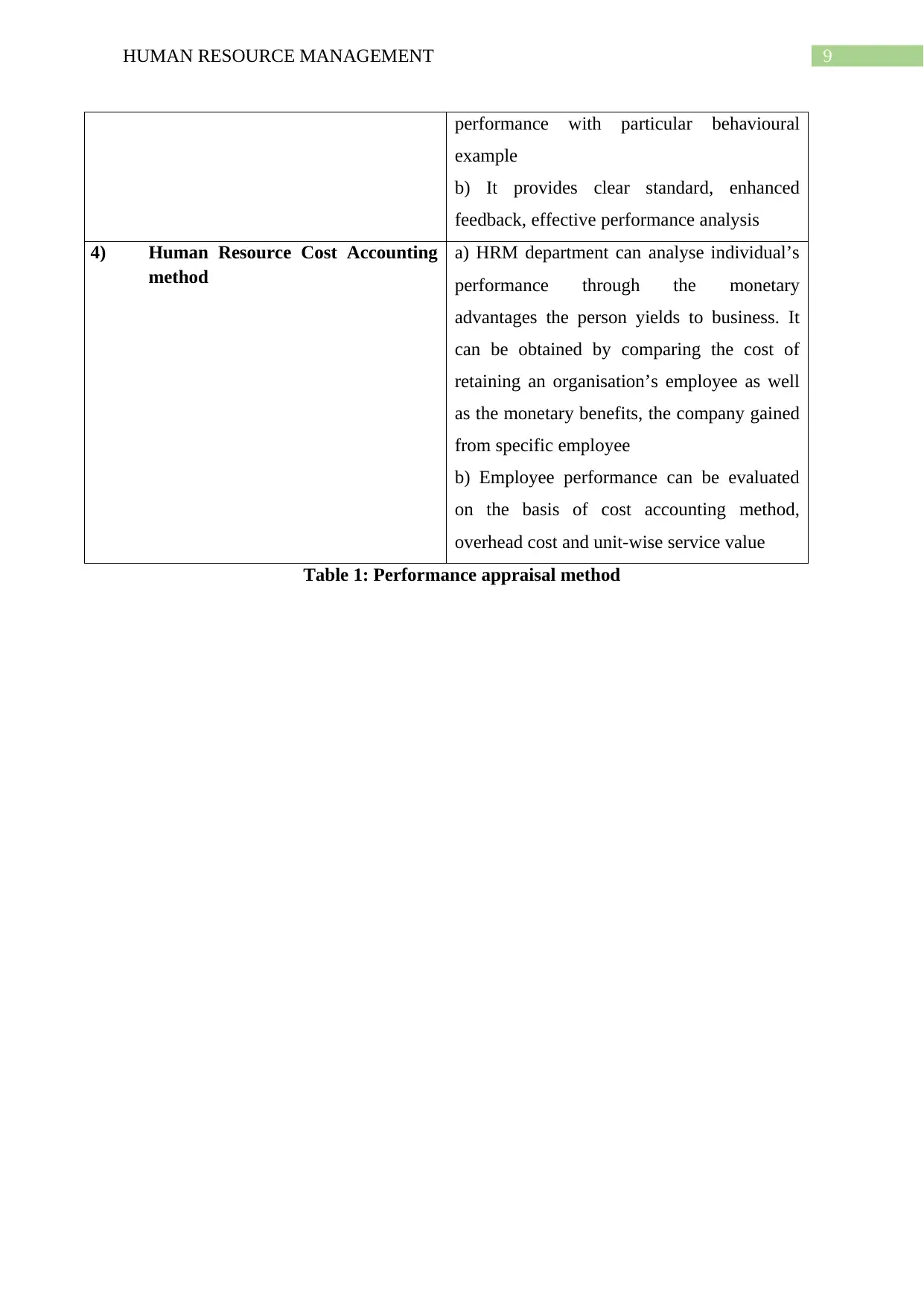
9HUMAN RESOURCE MANAGEMENT
performance with particular behavioural
example
b) It provides clear standard, enhanced
feedback, effective performance analysis
4) Human Resource Cost Accounting
method
a) HRM department can analyse individual’s
performance through the monetary
advantages the person yields to business. It
can be obtained by comparing the cost of
retaining an organisation’s employee as well
as the monetary benefits, the company gained
from specific employee
b) Employee performance can be evaluated
on the basis of cost accounting method,
overhead cost and unit-wise service value
Table 1: Performance appraisal method
performance with particular behavioural
example
b) It provides clear standard, enhanced
feedback, effective performance analysis
4) Human Resource Cost Accounting
method
a) HRM department can analyse individual’s
performance through the monetary
advantages the person yields to business. It
can be obtained by comparing the cost of
retaining an organisation’s employee as well
as the monetary benefits, the company gained
from specific employee
b) Employee performance can be evaluated
on the basis of cost accounting method,
overhead cost and unit-wise service value
Table 1: Performance appraisal method
Paraphrase This Document
Need a fresh take? Get an instant paraphrase of this document with our AI Paraphraser
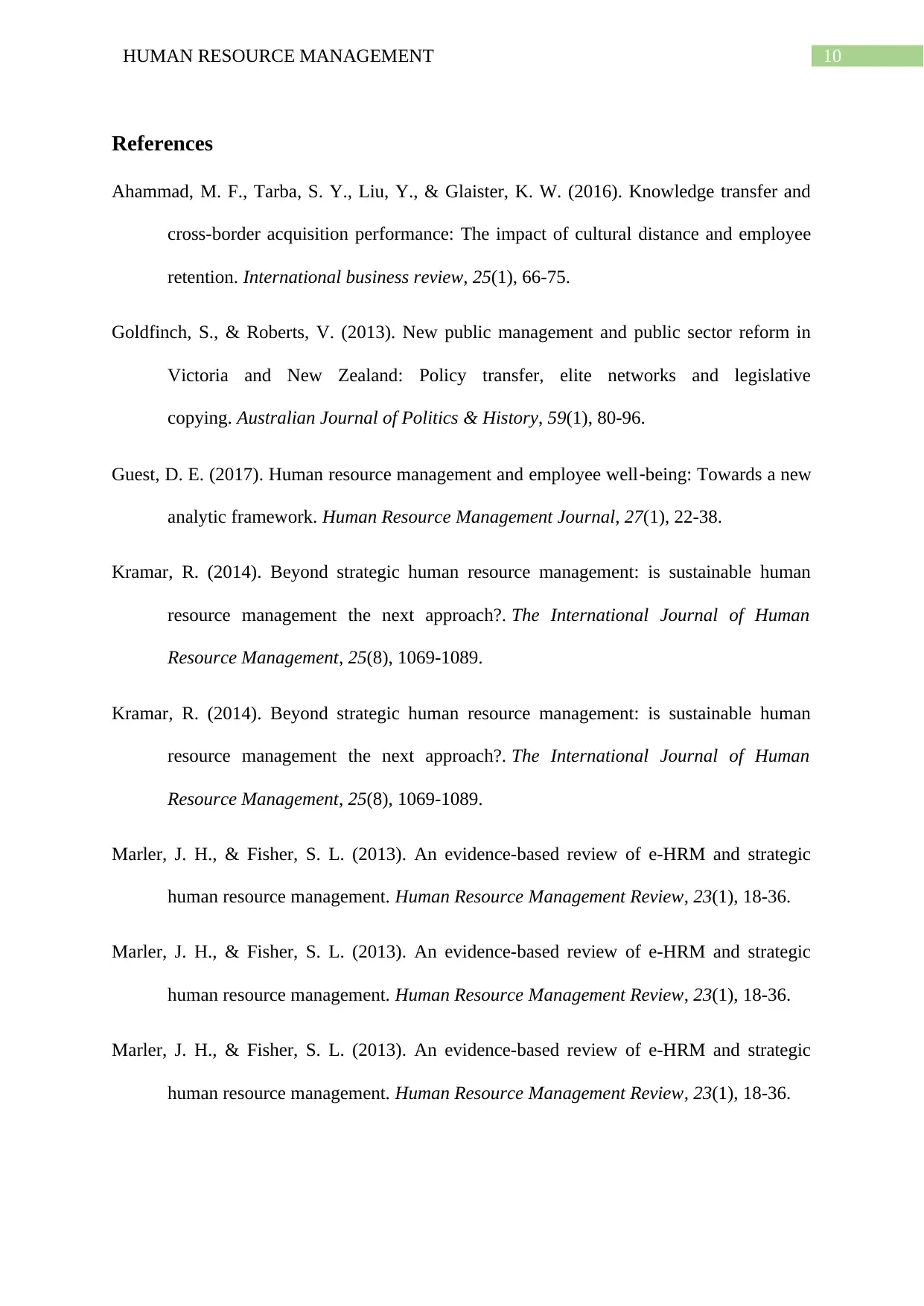
10HUMAN RESOURCE MANAGEMENT
References
Ahammad, M. F., Tarba, S. Y., Liu, Y., & Glaister, K. W. (2016). Knowledge transfer and
cross-border acquisition performance: The impact of cultural distance and employee
retention. International business review, 25(1), 66-75.
Goldfinch, S., & Roberts, V. (2013). New public management and public sector reform in
Victoria and New Zealand: Policy transfer, elite networks and legislative
copying. Australian Journal of Politics & History, 59(1), 80-96.
Guest, D. E. (2017). Human resource management and employee well‐being: Towards a new
analytic framework. Human Resource Management Journal, 27(1), 22-38.
Kramar, R. (2014). Beyond strategic human resource management: is sustainable human
resource management the next approach?. The International Journal of Human
Resource Management, 25(8), 1069-1089.
Kramar, R. (2014). Beyond strategic human resource management: is sustainable human
resource management the next approach?. The International Journal of Human
Resource Management, 25(8), 1069-1089.
Marler, J. H., & Fisher, S. L. (2013). An evidence-based review of e-HRM and strategic
human resource management. Human Resource Management Review, 23(1), 18-36.
Marler, J. H., & Fisher, S. L. (2013). An evidence-based review of e-HRM and strategic
human resource management. Human Resource Management Review, 23(1), 18-36.
Marler, J. H., & Fisher, S. L. (2013). An evidence-based review of e-HRM and strategic
human resource management. Human Resource Management Review, 23(1), 18-36.
References
Ahammad, M. F., Tarba, S. Y., Liu, Y., & Glaister, K. W. (2016). Knowledge transfer and
cross-border acquisition performance: The impact of cultural distance and employee
retention. International business review, 25(1), 66-75.
Goldfinch, S., & Roberts, V. (2013). New public management and public sector reform in
Victoria and New Zealand: Policy transfer, elite networks and legislative
copying. Australian Journal of Politics & History, 59(1), 80-96.
Guest, D. E. (2017). Human resource management and employee well‐being: Towards a new
analytic framework. Human Resource Management Journal, 27(1), 22-38.
Kramar, R. (2014). Beyond strategic human resource management: is sustainable human
resource management the next approach?. The International Journal of Human
Resource Management, 25(8), 1069-1089.
Kramar, R. (2014). Beyond strategic human resource management: is sustainable human
resource management the next approach?. The International Journal of Human
Resource Management, 25(8), 1069-1089.
Marler, J. H., & Fisher, S. L. (2013). An evidence-based review of e-HRM and strategic
human resource management. Human Resource Management Review, 23(1), 18-36.
Marler, J. H., & Fisher, S. L. (2013). An evidence-based review of e-HRM and strategic
human resource management. Human Resource Management Review, 23(1), 18-36.
Marler, J. H., & Fisher, S. L. (2013). An evidence-based review of e-HRM and strategic
human resource management. Human Resource Management Review, 23(1), 18-36.
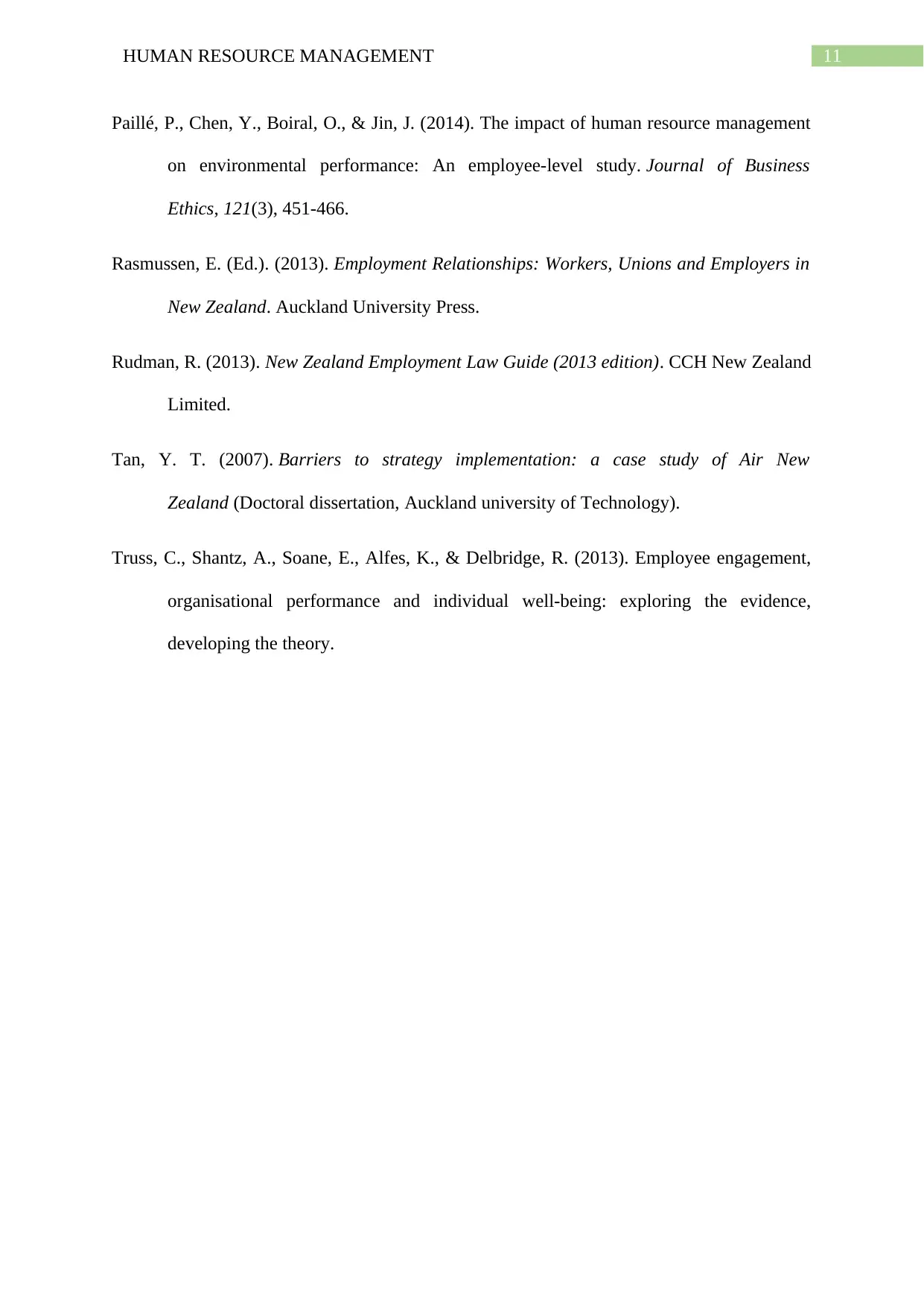
11HUMAN RESOURCE MANAGEMENT
Paillé, P., Chen, Y., Boiral, O., & Jin, J. (2014). The impact of human resource management
on environmental performance: An employee-level study. Journal of Business
Ethics, 121(3), 451-466.
Rasmussen, E. (Ed.). (2013). Employment Relationships: Workers, Unions and Employers in
New Zealand. Auckland University Press.
Rudman, R. (2013). New Zealand Employment Law Guide (2013 edition). CCH New Zealand
Limited.
Tan, Y. T. (2007). Barriers to strategy implementation: a case study of Air New
Zealand (Doctoral dissertation, Auckland university of Technology).
Truss, C., Shantz, A., Soane, E., Alfes, K., & Delbridge, R. (2013). Employee engagement,
organisational performance and individual well-being: exploring the evidence,
developing the theory.
Paillé, P., Chen, Y., Boiral, O., & Jin, J. (2014). The impact of human resource management
on environmental performance: An employee-level study. Journal of Business
Ethics, 121(3), 451-466.
Rasmussen, E. (Ed.). (2013). Employment Relationships: Workers, Unions and Employers in
New Zealand. Auckland University Press.
Rudman, R. (2013). New Zealand Employment Law Guide (2013 edition). CCH New Zealand
Limited.
Tan, Y. T. (2007). Barriers to strategy implementation: a case study of Air New
Zealand (Doctoral dissertation, Auckland university of Technology).
Truss, C., Shantz, A., Soane, E., Alfes, K., & Delbridge, R. (2013). Employee engagement,
organisational performance and individual well-being: exploring the evidence,
developing the theory.
⊘ This is a preview!⊘
Do you want full access?
Subscribe today to unlock all pages.

Trusted by 1+ million students worldwide
1 out of 12
Related Documents
Your All-in-One AI-Powered Toolkit for Academic Success.
+13062052269
info@desklib.com
Available 24*7 on WhatsApp / Email
![[object Object]](/_next/static/media/star-bottom.7253800d.svg)
Unlock your academic potential
Copyright © 2020–2025 A2Z Services. All Rights Reserved. Developed and managed by ZUCOL.



